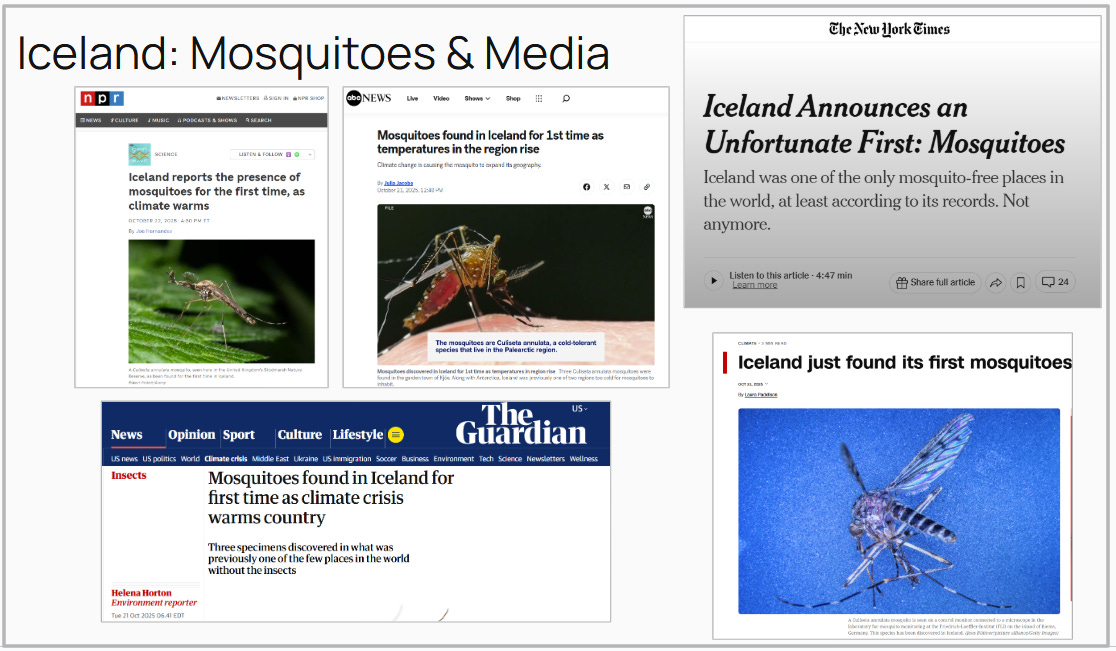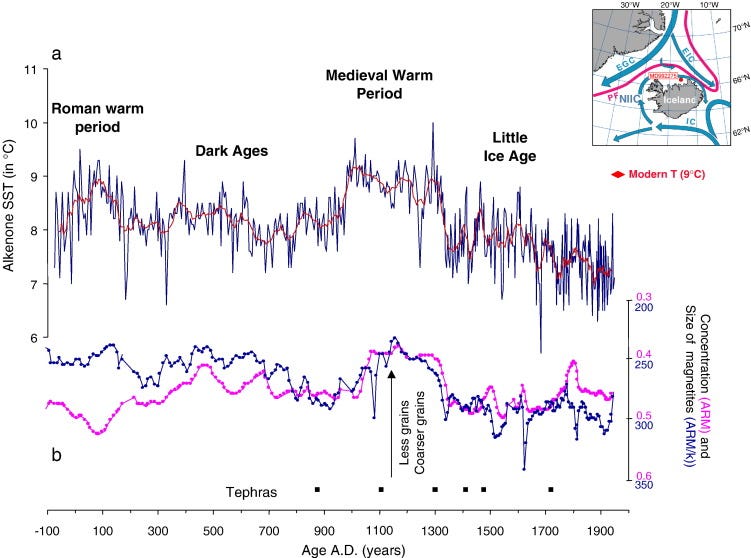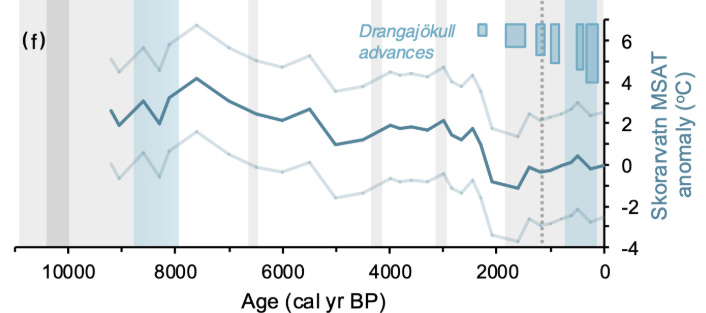https://irrationalfear.substack.com/p/when-climate-related-extreme-weather
DR. MATTHEW WIELICKI
In recent days, mainstream media has been buzzing about the discovery of mosquitoes in Iceland for the first time, framing it as undeniable proof that global warming is pushing these insects into new territories. Headlines from outlets like The Guardian, ABC News, CNN, The New York Times, and NPR all echo the same narrative: climate change is warming Iceland, making it hospitable for mosquitoes, which were previously absent from the island.

Iceland, along with Antarctica, is often cited as one of the few places on Earth without mosquitoes in modern times or the fossil record. But this argument is deeply flawed, relying on selective ignorance of history, biology, and basic logic.
Thanks for reading Irrational Fear! This post is public so feel free to share it.
Irrational Fear is a reader-supported publication. To receive new posts and support my work, consider becoming a free or paid subscriber.
Let’s start with the basics of Earth’s history. Antarctica, for instance, boasts abundant coal deposits, which are the compacted remnants of ancient swamps. These deposits, found in regions like the Prince Charles Mountains and the Transantarctic Mountains, date back to periods like the Carboniferous (around 359-299 million years ago), when the continent was covered in lush, swampy forests. Coal forms from plant material in these wet, stagnant environments, and you can often see preserved ferns and other vegetation in coal seams. This is distinct from oil and gas, where organic matter breaks down into kerogen and loses most fossil evidence, fueling fringe theories like abiotic oil. But in coal, the plant remnants are clear.
Now, if you visit a modern swamp, one thing hits you immediately: mosquitoes. These environments, with their stagnant water and abundant organic matter, are prime breeding grounds. Yet, the alarmists claim mosquitoes couldn’t exist in places like ancient Antarctica due to cold. That’s nonsense—those ancient swamps were teeming with life, and while mosquito fossils are rarely found in coal itself (they’re more commonly preserved in amber, as seen in 46-million-year-old specimens from Montana or 130-million-year-old ones from Lebanon), the conditions would have supported them.
This brings us to one of the core fallacies: the idea that mosquitoes are strictly tied to warm temperatures. My wife and I both did our PhDs on early Earth geology, and she spent extensive time in northern Manitoba, where ancient rocks are exposed. During the brief summer months, when the region is accessible, the mosquitoes are ferocious. This is an area frozen solid for much of the year, yet it has some of the worst mosquito swarms on the planet. The same goes for Alaska, where mosquitoes overwinter by tolerating temperatures as low as -25°F and emerge in massive numbers during the thaw. Mosquitoes thrive in cold climates as long as there’s a summer breeding window; temperature isn’t the barrier.
So why no mosquitoes in Iceland until now? It’s not about warmth, it’s about isolation. Iceland’s remote location in the North Atlantic has historically prevented colonization by these insects. But consider the Medieval Warm Period (MWP, roughly 800-1250 CE), when conditions were milder than today. Peer-reviewed reconstructions show that during the MWP, summer sea surface temperatures in Iceland remained high after Norse settlement around 870 CE, with overall climates favorable and reduced sea ice compared to the 20th century.

July temperatures were likely 2-3°C warmer than present, based on proxy data from lake sediments and ice cores. For instance, a study in Earth and Planetary Science Letters highlights milder MWP conditions around northern Iceland, with quotes like: “the climatic conditions around northern Iceland during the MWP were favorable, i.e. milder than in the 20th century with reduced sea-ice cover”. If temperature were the issue, mosquitoes should have arrived then. They didn’t… because Iceland was isolated.
Even more compelling, going further back to the Holocene Thermal Maximum (HTM, approximately 7900 to 5500 years before present), Iceland experienced even greater warmth under pre-industrial CO2 levels. A high-resolution Holocene record from Torfdalsvatn, north Iceland, detailed in a peer-reviewed study, reconstructs mean summer air temperature anomalies.

This figure, based on lipid biomarker analyses from lake sediment cores at Skorarvatn, NW Iceland, shows temperatures peaking during the HTM at about 3°C warmer than present-day conditions. As the study notes, “current estimates suggest that summer temperatures were ∼ 3 °C warmer than present.” This natural warmth, driven by factors like Northern Hemisphere summer insolation and ocean currents, occurred without elevated greenhouse gases, directly contradicting claims that current minor warming is uniquely anthropogenic and responsible for ecological shifts like mosquito arrivals.
It’s ironic that the very paleoclimate records often invoked to push the climate crisis narrative can so easily disprove it by showing warmer past periods under natural conditions.
Today, that’s changed dramatically due to human activity. We’re in an interconnected global economy with skyrocketing travel and trade. Iceland’s tourism, for example, exploded from about 595,000 overnight stays by foreign visitors in 2000 to over 2.1 million by 2010, and reaching 2.5 million international arrivals in 2024, a factor of nearly 4 increase overall. Add in imported goods, like agricultural products that could hitchhike mosquitoes, and it’s no mystery how they got there. This isn’t climate apocalypse; it’s globalization.
This mosquito scare is just the latest example of cherry-picking data to fit a narrative, ignoring historical context and alternative explanations. It’s how the “climate sausage” gets made… twist any anomaly into proof of doom, facts be damned.
Once again, this is a free article, but IrrationalFear.com is a subscriber-supported publication. Without the support of my subscribers, none of this would be possible. If you can, please subscribe at irrationalfear.com for access to over 400 unique articles by me, Dr. Matthew Wielicki, professor of earth science-in-exile.



